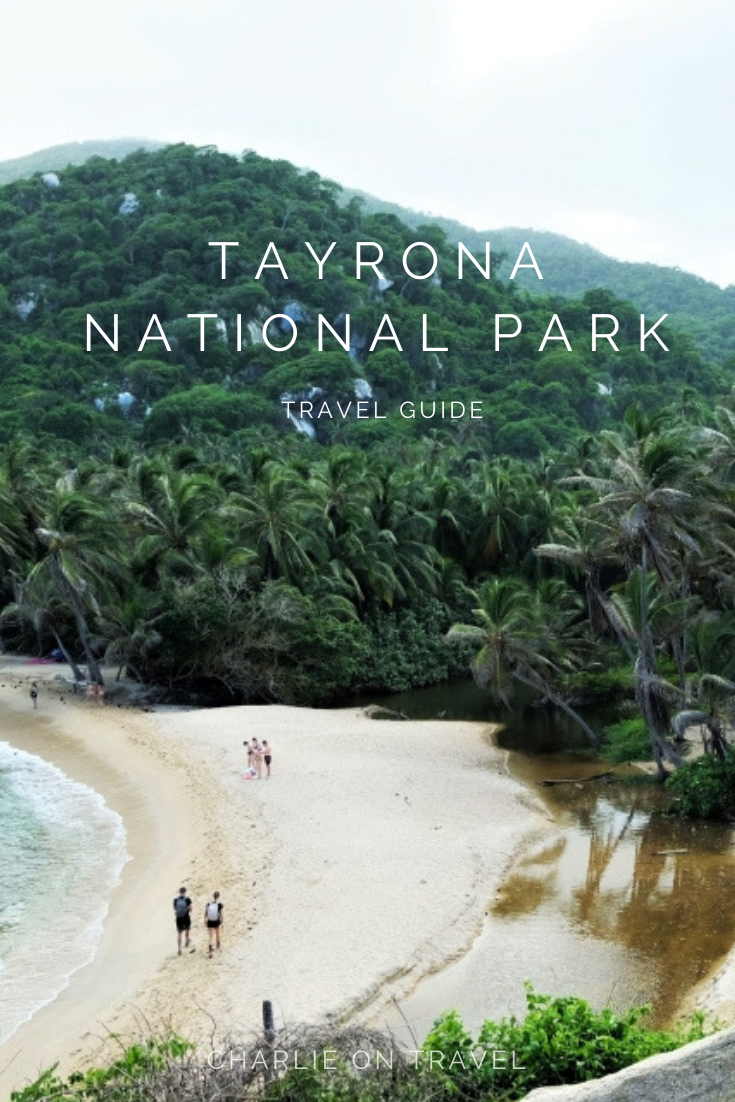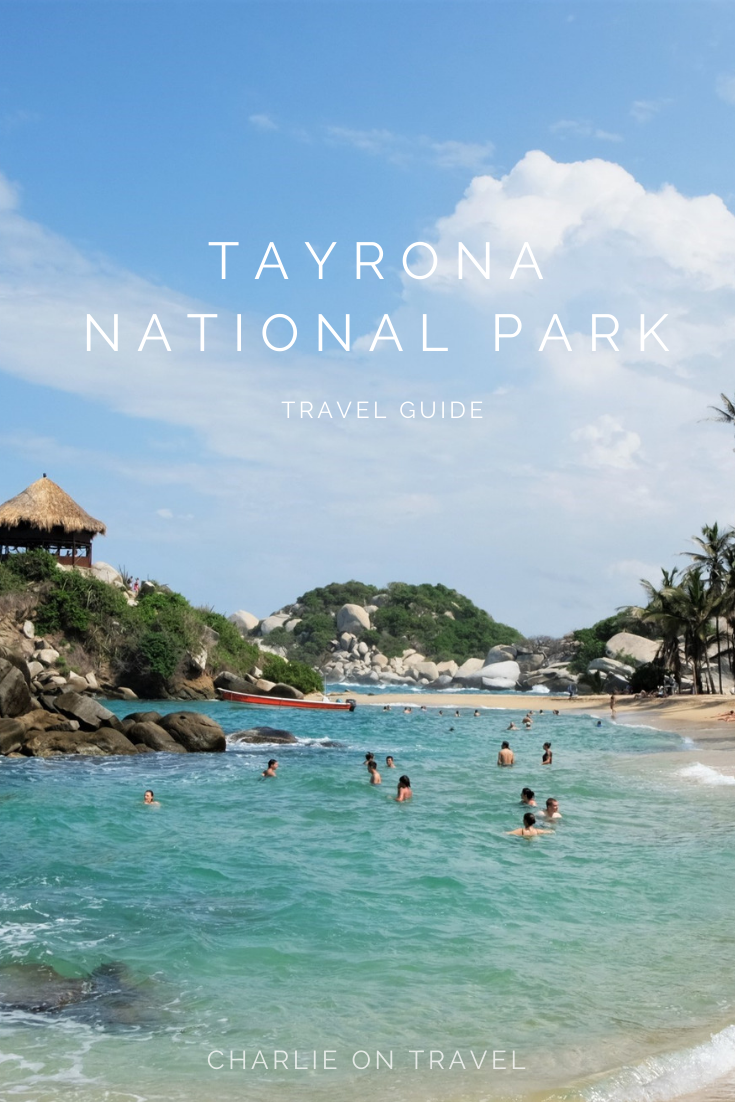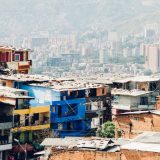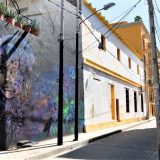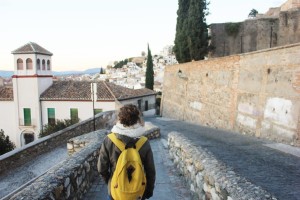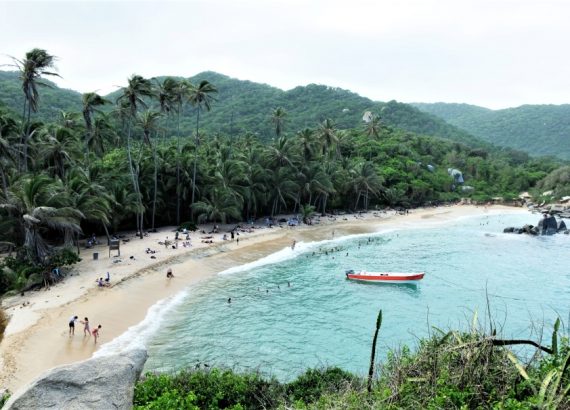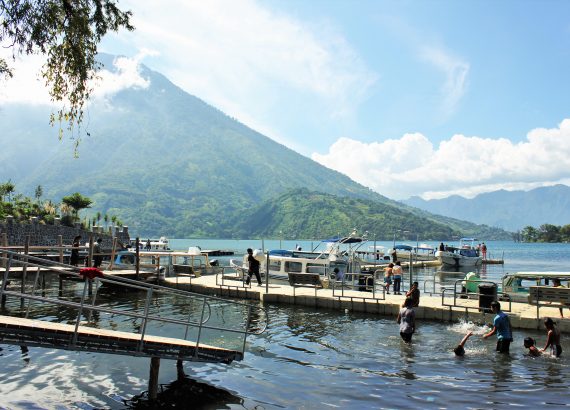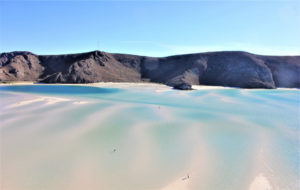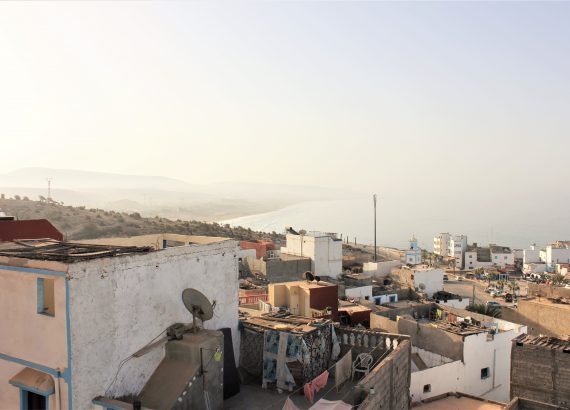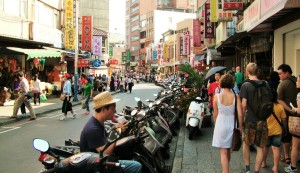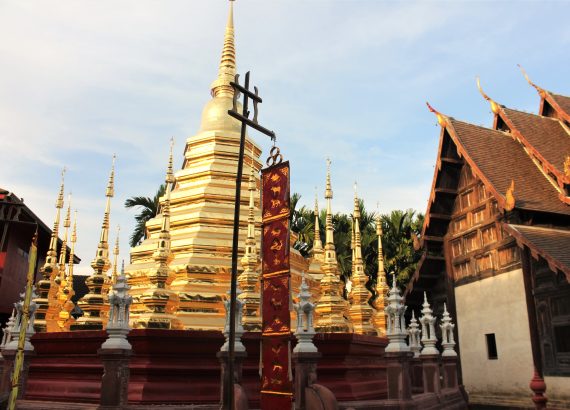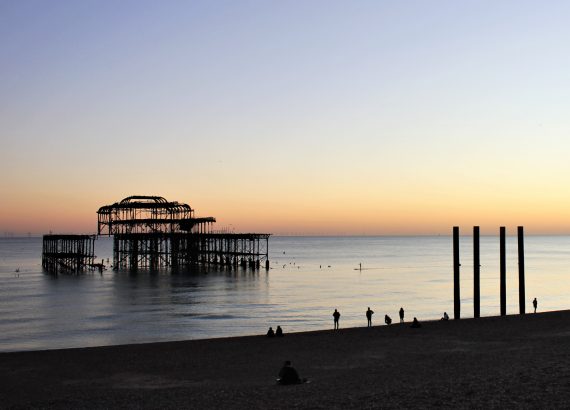Tayrona National Park — A Hike Through Jungles and Beaches
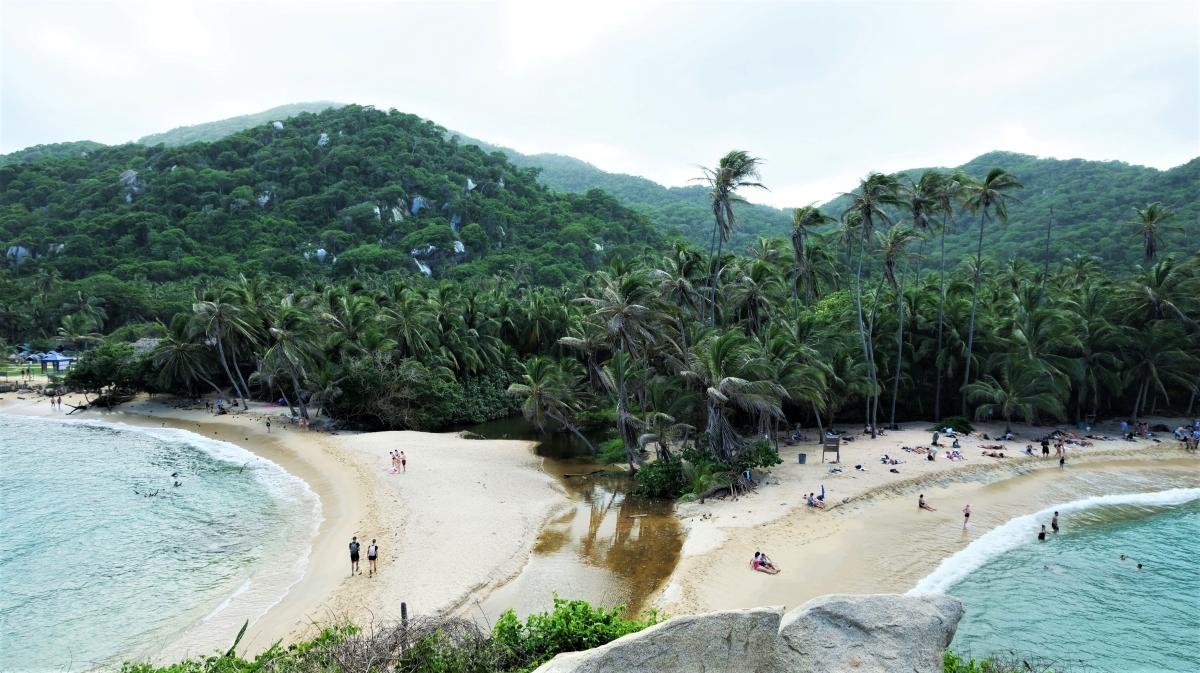
Tayrona National Park — a glorious place where jungle meets beach. This travel guide takes you through how to get to Tayrona and the jungle hike to get to the best beaches once you’re there.
If you’ve been to beaches in Mexico and the Philippines, lower your expectations for Colombia’s beaches. They’re gorgeous but they’re not the white sand paradise beaches from the magazines. Most notably because currents are strong and swimming is not allowed on many of the beaches. If like us you’re a lover of jungles, mountain landscapes and enjoy hiking coastlines rather than laying on the sand, then feast your eyes on this:

When To Visit Tayrona National Park
This is really important! I’ve heard disillusioned travellers dispirited by how crowded with tourists Tayrona was. This wasn’t our experience of the park at all, which means if you’re entering Tayrona in low season like us, then you’ll have clear paths and only pass by a handful of other hikers here and there.
Whereas if you’re visiting in high season, you can expect to be sharing with hundreds of other tourists and locals going in the same direction as you. We’ve heard this can mean overcrowding on Cabo San Juan beach (the one you’ll recognise from the photos). If you can, avoid the throngs of tourists by visiting Tayrona in low season like we did.
High season is December and January. Colombians have their holidays during this month and many travel up to Tayrona’s beaches for some sun and sand. Easter week and all other holy weekends are also peak times when the park is likely to be busy. The remaining time of the year, and particularly week days, are considered low season. September and October are the rainiest months but usually the rain doesn’t last too long so you can continue your hike. We visited in October and had a cloudy but rain-free day.
Tayrona National Park is closed during February and from 15th June – 15th July. This happened during 2018 and 2019 and is planned for 2020. The park closes completely every year at the request of the indigenous communities of the Sierra Nevada de Santa Marta for whom Tayrona is home. Following the thousands of tourists who traipse through the park, the closure provides are period of rest for the ecosystems within the park. During this time, the indigenous groups who live in Taryona have their own cleansing rituals for the land.
It goes without saying — plan your trip far enough in advance so that you know the park will be open. We fully support Tayrona National Park’s periods of planned closure and hope that more areas of natural and cultural significance will respectfully close their doors when needed, especially as tourism demand continues to rise.
Tayrona Park Opening Times: The main entrance at El Zaino is open from 8AM – 5PM, but last entry into the park is at 4PM.
How To Get into Tayrona
To get into Tayrona National Park, you need to buy a ticket. This can apparently be bought online but when we tried the booking system was down. If you’re travelling in high season, it’s recommended you buy a ticket in advance online as the park has a maximum capacity. If you’re travelling during low season, you can arrive on the day and buy a ticket at the entrance gate.
Tayrona National Park Entrance Cost: Entry to Tayrona National Park costs COP $54,500 for foreigners, COP $16,000 for Colombian citizens and COP $8,500 for students with a valid student ID. You must bring your passport with you.
Tayrona National Park Entrance Gates: There are three entrances to Tayrona: El Zaino, Calabazo and Palangana.
- El Zaino is the main entrance where most tourists enter the park. We arrived to El Zaino at opening time and still had to queue for half an hour to enter the park, though this seemed to be due to slow ticket processing rather than the number of people. After entering at El Zaino, you take a 10-minute ride in a collective truck costing COP $3000 per person to the start of the hiking route. The hike to the beaches from El Zaino is more direct and you’ll be able to see all the beaches within a day.
- Calabazo is almost like the back gate entrance to the main park. If you enter through Calabazo, the hike will be 3 hours to the main beaches and you would be pushed to make it back on the same day. However, the Calabazo is used less often and it could mean a quieter hiking path. If you’re entering the park during high season, I’d recommend considering this option. We also hear that because there are fewer people taking this route you’re more likely to spot wildlife, but we saw a troop of brown Capuchin monkeys on the route from El Zaino.
- Palangana is a separate entrance closer to Santa Marta and you cannot access the hiking paths or beaches that you can through the above two entrances. More about this route further down.
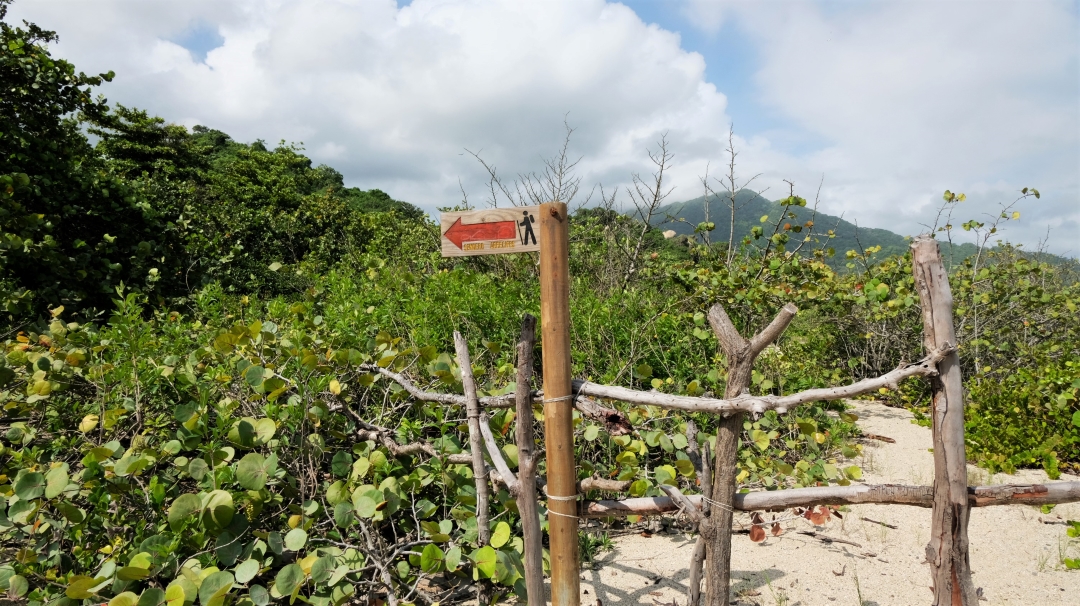
Tell Me About the Best Beaches in Tayrona!
Alright, alright, the bit you really want to read about. Which are the best beaches in Tayrona National Park and how do you get to them?
Tayrona actually has a lot of beaches within the park boundary. However, this is misleading because many of them are hard to get to and hard to find information about. Neguanje, Bahia Concha, Playa Gayraca and Playa Cristal are the less well-known beaches. Neguanje is the beach closest to Santa Marta and you can drive much closer, rather than hike. It’s these beaches that tend to also be accessed by the boat tours that leave from Santa Marta.
These beaches are accessible by a completely separate third entrance to Tayrona called Palangana. As Palangana is separate from the El Zaino and Calabazo entrances to the park, if you visit this area you cannot connect through the other beaches in Tayrona or to the hiking trails. There’s also a 300 visitor per day limit for Playa Cristal and it’s not a sure thing you can get tickets on the day. We didn’t visit these beaches but I’ve read mixed reviews about them and from what I gather, they don’t give the true Tayrona experience.
The beaches you want to know about are the ones that you’ll need to hike to, but are worth the jungle humidity, sweaty t-shirt and muddy shoes to get there:
Cañaveral — It’s one of the smallest beaches and where the inordinately expensive Ecohabs (eco bungalows costing $400+ per night) are located. The waters here are some of the most dangerous in the park and you cannot swim there. We opted to skip this beach and crack straight on to Arrecifes.
Arrecifes — Wind swept Arrecifes is one of the biggest beaches in Tayrona. It’s breadth is stunning, jungle vines crisscross out onto the sand and it’s flanked by towers of smooth grey rocks. We walked through the campsite — which was the nicest, most well-kept looking campsite within the park — and through a cut-out in the fence to the beach. We were the only ones there and settled on the rocks to admire the beach. The currents here are extremely strong and you cannot swim here. Over 100 people have died here, so that advice is to be taken seriously!
La Piscina — As the name suggests, La Piscina is a swimming beach. It’s a small bay keeping the waters calmer; though to be honest the waters weren’t that calm when we visited, so much so that I didn’t jump in despite being a sweaty mess.
Cabo San Juan — The famous Tayrona National Park beach! You’ll have seen this beach in all the pictures and it’s quite a sight. A rocky hill with a cabin atop rises out in the sea between two bays. Hammocks up there are in hot demand, so if you want one make sure to put you reservation in at the entrance gate. The beach is surrounded by thick jungle, with the lush green palms spreading over the golden sands that meeting the bright blue waters. There’s a campsite and restaurant here which is popular because of it’s beach-front location, though it didn’t look as well kept as Arrecifes.
Punta Piedra and Playa Nudista — Though it’s designated as a nudist beach, there wasn’t actually anyone there when we poked our heads round. The tide was really far in, so there was barely any beach to sit on.
Playa Brava — Playa Brava is separate from the other beaches and can only be reached by a 3-4 hour hike from the Calabazo entrance. You then have to double back on yourself in order to take the path round to Cabo San Juan. There’s not info about Playa Brava but there’s camping available there and I hear it’s the best beach in Tayrona to go to if you want it completely quiet and to yourself.
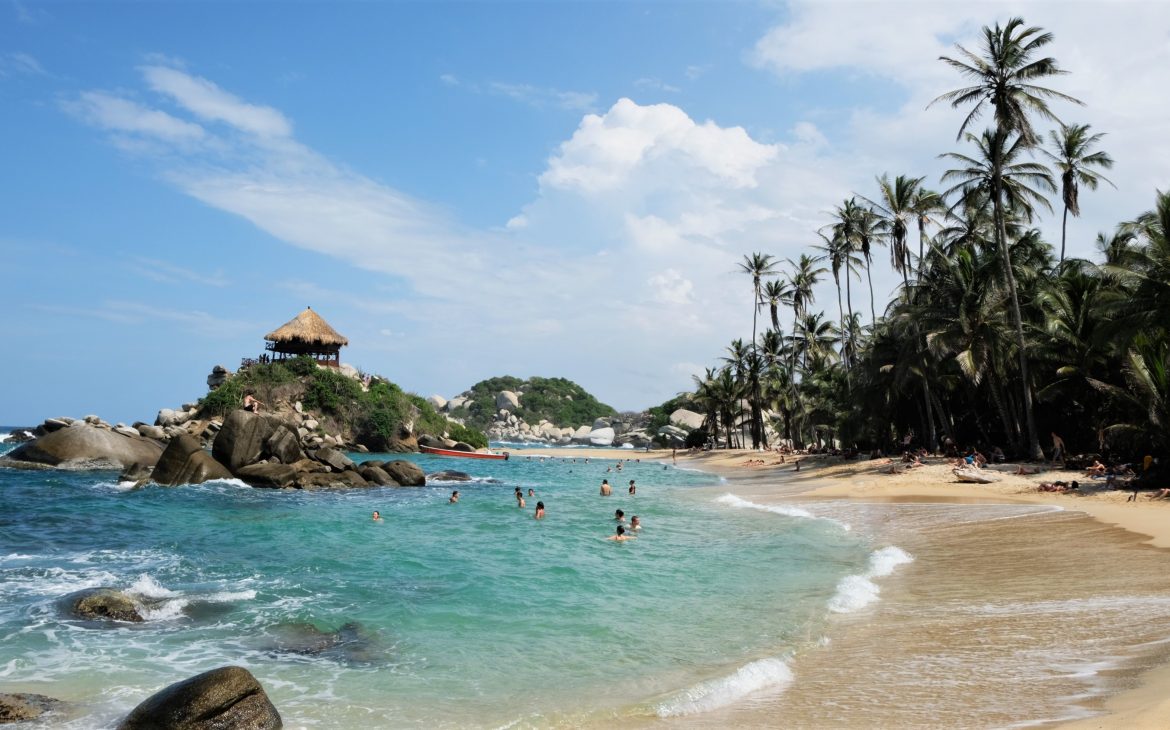
Cabo San Juan beach
How Do You Get to the Beaches?
You have to hike! From El Zaino entrance, you can hike to the beaches of Cañaveral, Arrecifes, La Piscina, Cabo San Juan, Punta Piedra and Playa Nudista. The hiking route is clear and straight-forward to follow. It’s an easy path with limited elevation but it can be muddy and the high humidity means the walk may feel like more of a moderate hike if you’re not a regular walker.
- Cañaveral is first beach on the Tayrona National Park hiking route if you enter through El Zaino and can beach reached not long after the walk starts.
- The walk to Arrecifes beach is an hour.
- La Piscina is a 20-30 minute walk from Arrecifes. You can walk straight along the beach or otherwise go back to take the route along the path.
- Cabo San Juan took us around 3 hours to reach, including stops at the other beaches on the way.
- Punta Piedra and the nudist beach are just a 15-minute or so walk further from Cabo San Juan.
If you really don’t want to hike (though you’d be missing out on the whole Tayrona experience), you can get a speed boat direct to Cabo San Juan from Taganga. This village has a bad reputation so be watchful of your belongings if you take this option. We explain how to organise this later on.
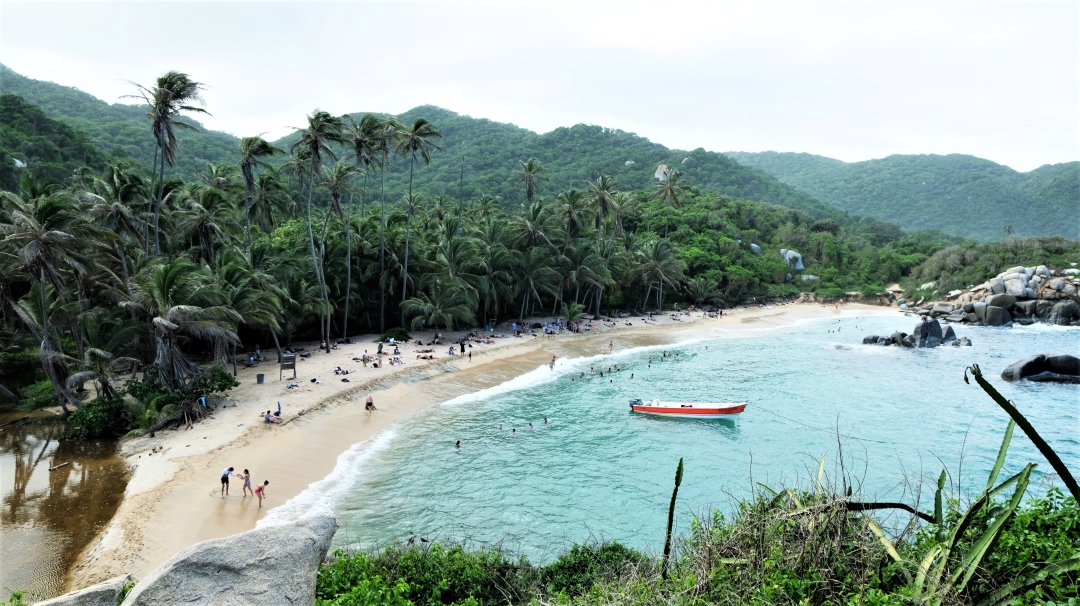
How Long To Spend in Tayrona?
How long you spend in Tayrona National Park will depend on how you enjoy spending your time, the season you travel in and the beaches you want to see. If you’re keen to do a day’s hiking and see the three beaches of Arrecifes, La Piscina and Cabo San Juan then this do-able.
We travelled in rainy season and though there wasn’t rain during the day, there were rainstorms at night. We decided we’d rather stay in a cabin outside of Tayrona and enter for a day-hike, rather than risk getting battered by a storm in a tent or hammock on Tayrona’s beaches. If we’d been at Tayrona in a different season, we might’ve made a different choice although we were pleased to have a decent shower and a fan at night and get rid of the sticky, salty feeling after a day in Tayrona.
We arrived at opening time and were on the trail by 9AM. It was low season so the trail wasn’t busy and we’d made it to Cabo San Juan by 12PM including stops at Arrecifes and La Piscina on the way. Preferring to hike rather than sit on the beach, we only spent a few hours at Cabo San Juan swimming and lunching. We walked along to the other beaches, then started our route back by 3PM to reach the park exit by 5PM, stopping for a drink at Arrecifes and watching the sun start to go down near the end of the trail.
If you want to also see Playa Brava then you’ll need to stay overnight there before making your way to Cabo San Juan, La Piscina and Arrecifes the next day. If you want to take it slow or spend some real leisure time soaking up rays on the beach then you’ll also want to stay overnight in Tayrona so you don’t feel rushed. We’ve also heard that the beaches can be so packed in high season that waking up to empty beaches at sunrise is the best way to fully appreciate Tayrona and I bet it would be magical.
That said, we were fully satisfied by our day-long hike in Tayrona and the two nights we spent staying at a cabin in the jungle outside of the park. It felt like a full weekend away in the jungle and for us the hike was easily do-able in a day.
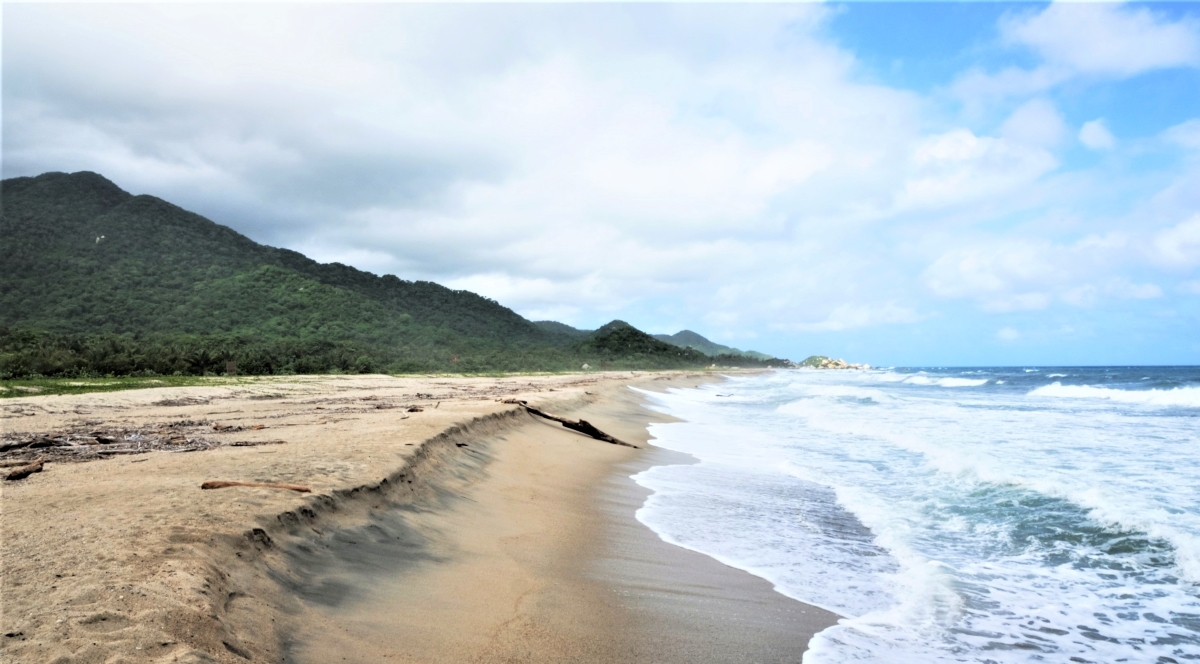
Arrecifes beach
Where To Stay in Tayrona National Park
Where to stay in Tayrona National Park depends on what you want to do there, but broadly speaking there are three options: camp inside Tayrona National Park, stay at accommodation just outside the park, or stay in the nearest town of Santa Marta.
Camping in Tayrona National Park
Embrace your sweaty and sticky self and camp in Tayrona if you want more beach time and to see sunrise or sunset in the park. There are camping options throughout the park. We opted to stay in accommodation outside of the park instead, but we had a good snoop at the campsites we passed.
Arrecifes Campsite — The Arrecifes campsite looked the most well-kept and had a nice restaurant facility — nothing too fancy — and a clean toilet block. You can borrow a tent or bring your own and pitch it in the green grassy area. There’s a cut-through to the beach but the downside is that Arrecifes doesn’t offer beach-front camping and you cannot swim at this beach.
There was a campsite just up the path from Arrecifes which looked abysmal. I’d avoid staying there at all costs.
Cabo San Juan Campsite — Cabo San Juan is the most popular place to camp and here you have the option to stay in a hammock, rent a tent or bring your own. The camping is beach-front and you can swim at the beach here. However, this is also the most crowded campsite as a result. There’s a basic restaurant with reasonably priced food. Cabo San Juan campsite we prices were COP $50,000 for a hammock or COP $40,000 per person for a tent. If you have your own tent, you can pay a cheaper price to pitch it.
Tip! You don’t want to be slogging it through the hot jungle with a massive backpack and all your kit. If you plan to stay overnight in the park, ask your last hotel or hostel to store your bags overnight.
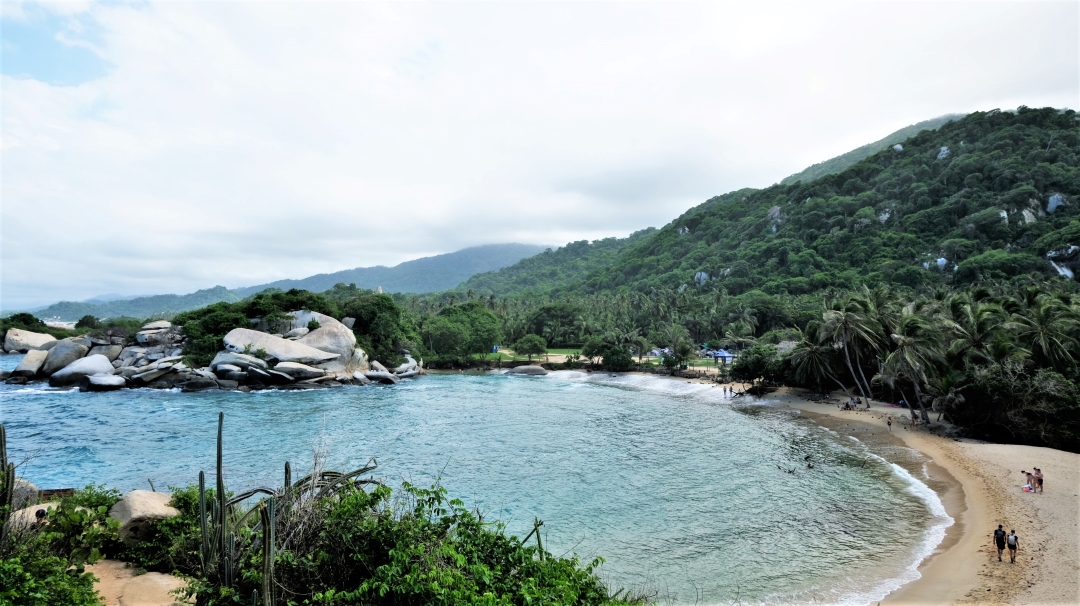
Cabo San Juan campsite in the background on the beach there
Jungle Accommodation Outside Tayrona National Park
The Route 90 road runs along the back of Tayrona National Park and this is where the El Zaino and Calabaza entrances are located. Along this road and up into the jungle are various campsites, hostels, hotels, cabins and guesthouses. What’s most important is to pick a place within a decent walking distance to the gate you want to enter through as walking along the road isn’t pleasant.
We stayed in a sweet cabin we found on Airbnb just 10 minutes walk from the El Zaino entrance for two nights. We stayed the night before our hike so we could enter the park as soon as it opened at 8AM and overnight after our hike. We loved the feeling of still being in the jungle area but with the comforts of four walls, a shower, a normal bed and fan after a sweaty day in the park.
Our top recommendation! We discovered a jungle gem called Barranquero Hotel when we ventured out for food. The food was excellent, the place was gorgeous and the staff so attentive that for the extra few quid we would definitely recommend this as the best place to stay in Tayrona. Getting to the hotel is a bit of an adventure because you’ll need to take your shoes off and cross a river!

Beach-Side Accommodation in Costeño
If you want to maximise your beach time, rather than jungle time then there’s the option to stay at the nearby beach village of Costeño. The village is further down the road than the options mentioned above, so to reach the park you’ll need to hop in a cab or moto-taxi. It’s possible to enter Tayrona for a day hike from here if you wake up early. We heard of some taxis overcharging tourists for lifts to the park entrance, so be careful to negotiate or team up with other travellers to get a better price.
Accommodation in Santa Marta
Santa Marta is a port city about 45 minutes to an hour outside of Tayrona National Park. The city is fine, but we wouldn’t recommend going from there and back again in the same day. Firstly, because it’d be a rush to get into the park and out in time. But secondly, and more importantly, because you wouldn’t get a real feeling of staying in the jungle for a few days.
Even if you’re tight on time, I’d recommend trying to have at least one night camping in Tayrona or staying in accommodation just outside the park and skipping Santa Marta instead.
What To Bring To Tayrona National Park
Bring only what you need! The hike is extremely humid and you definitely won’t want a full travel backpack on your back. Plus, there isn’t really anywhere to store your stuff in the park, so it’s better to come only with your valuables and leave any other belongings in a storage place outside the park. Many hostels offer lockers where you can leave your kit, though they’re not always the most secure so don’t leave anything too valuable in there.
What you will need to bring to Tayrona:
- Enough money! There are no ATMs in Tayrona, so make sure you withdraw enough to pay for your transport, park entry, any food and drink, and accommodation.
- Sunscreen. Even though most of the hike is shaded by jungle canopy, you’ll still need to top up for the beach.
- Bug spray. You’ll get nipped a lot by mosquitoes, so spray up. Even better, wear long sleeves and trousers.
- Swim kit and towel. Because you’re going to the beach!
- Sunglasses.
- Lightweight rain jacket.
- Trainers or hiking boots. We don’t recommend doing the hike in flip-flops or sandals, but trainers will be absolutely fine.
- Overnight toiletries and spare clothes! If you’re staying overnight, it gets chilly in a hammock so bring something warm.
- Book. There’s no wifi in the park, so you might need the entertainment.
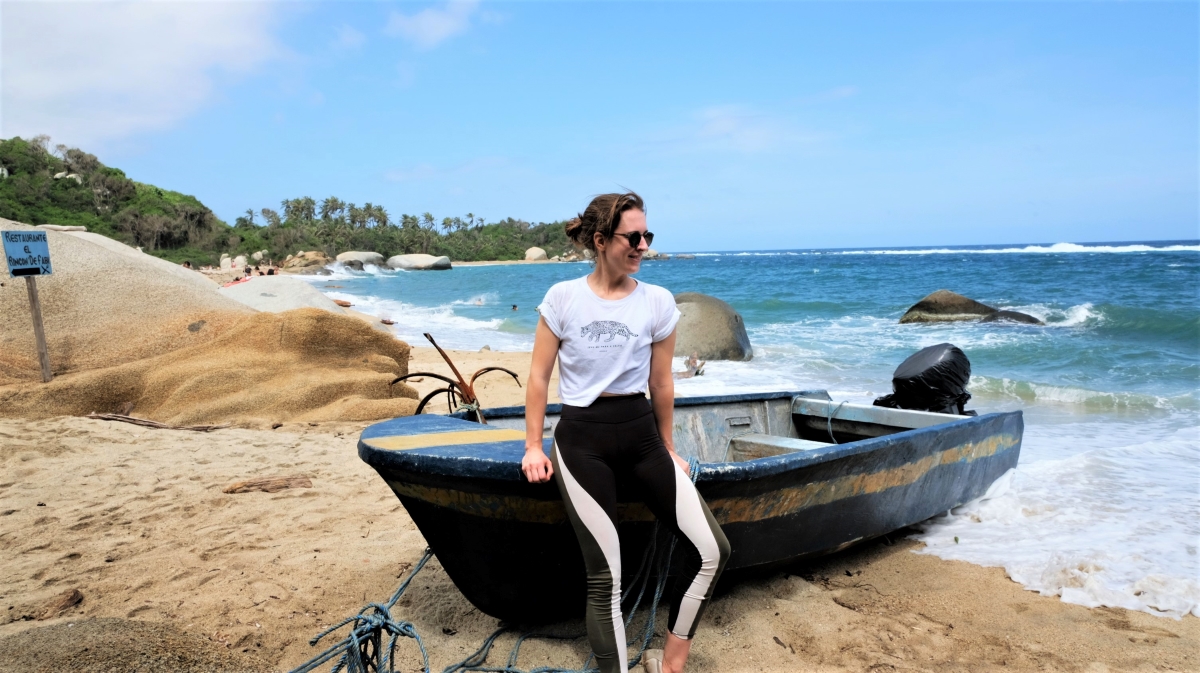
How Much To Budget for Tayrona National Park
There are no ATMs in Tayrona National Park (of course. because it’s the jungle) or along the roadside. You’ll need to withdraw enough money for your Tayrona trip in Santa Marta or whichever town you’re travelling from ahead of time. Here’s what you’ll need to budget for Tayrona (prices in Colombian pesos):
- Tayrona National Park Entrance Ticket — $54,500
- Collectivo inside the park (both ways) — $6000
- 2 litres of water (bought outside the park) —$5000
- Food inside the park — $15,000-25,000 per meal
- 1 beer (inside the park) — $5000
- Hammock inside the park — $40,000
- Bus to and from Santa Marta — $14,000
- Total: $149,500 COP (£35 / $45 / €41)
We saved on costs by bringing food supplies after hearing it could be expensive to buy food in the park. We came prepared with cereal, fruits and guacamole wraps. Inside the park, you’ll pay $15,000 for a plate of rice and veggies which we thought wasn’t a bad price considering how deep in the jungle you are. Cheap sandwiches were for sale at $7000 but I’m not sure I’d risk it.
We’d also recommend booking your accommodation outside of the park in advance so you don’t have to carry as much money with you. We booked and paid for our Airbnb online beforehand.
How To Get to Tayrona National Park
From Cartagena — If you’re travelling from Cartagena, you’ll have to go via Santa Marta. You can either stop there for the night or it is possible to travel from Cartagena to accommodation outside of Tayrona National Park’s entrance on the same day.
Bus from Santa Marta — A public bus runs from the Public Market in Santa Marta to Tayrona every 30 minutes. The buses run until 6PM. After 6PM, you’ll need to take a taxi to reach Tayrona National Park. You’ll need to know where you want to jump off and let the bus assistant know ahead of time. Cost: COP $7000 per person.
Taxi from Santa Marta— A taxi from Santa Marta to Tayrona National Park is much faster and the only way to reach the park if you’re arriving after 6PM. We jumped in a taxi to reach the market to take the bus and had no intention of going by taxi to the park. We knew the going rate for a taxi to Tayrona was COP $100,000 and didn’t want to spend the extra cash when we had plenty of time for the bus.
Our taxi driver wasn’t perturbed though and eventually dropped down to COP $50,000 reasoning that he’d be able to run a collectivo and pick up other passengers. For that price, we couldn’t say no. In the end he didn’t find any other passengers so I’m not sure such a cheap journey was really worth it for him, but it’s possible to negotiate a better than standard rate with the taxi drivers.
Cost: COP $50,000-$100,000, but you’ll have to negotiate.
Boat from Taganga — A 15-minute drive from Santa Marta will get you to the beach town of Taganga. From here, speedboats run at 10AM to Cabo San Juan beach in Tayrona. It means you can cut off the hiking and go directly to the most popular beach in Tayrona, but it is an expensive and, from what we hear, uncomfortable option. Boats return from Cabo San Juan at 4PM and you’ll hear the boat guys calling for the return passengers. The ride is 45 minutes each way. Cost: COP $50,000 per person.
Bus from Palomino — If you’re travelling to Tayrona from the east instead, you have the option to stay in the backpacker town of Palomino. It didn’t sound like our jam, so we skipped heading out this way but others we met said they liked it. A morning bus leaves Palomino and takes around 45 minutes. Cost: COP $7000 per person.
How To Get Out of Tayrona National Park
Once you’ve walked back to the entrance gate of the park, you’ll have no trouble getting back to where you want to go. Taxis and motorbike taxis will be there ready to take you, and if you’re out before 6PM you also have the option to wait for the bus. We chose to stay in a cabin just 10 minutes walk from the entrance so we could shower and collapse right after our hike!
Is Tayrona Worth the Trip?
Yes, absolutely! We loved our hike in Tayrona and felt the costs were reasonable. Bear in mind that we travelled in low season and there were only a handful of other people. We felt like we got a true Tayrona experience of secluded beaches (at Arrecifes anyway), stretches of undisturbed jungle paths and a spotting of wild Capuchin monkeys. If you’re travelling in high season, you might not be met with the same experience but we’d recommend Tayrona stays on your itinerary.
Some of the links in this post are affiliate links, which help to run Charlie on Travel. None of these links will ever cause you to pay an additional amount. I only link to brands I personally use and like.
